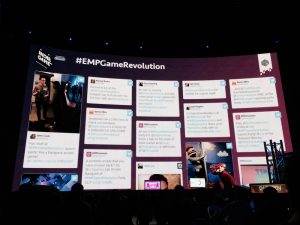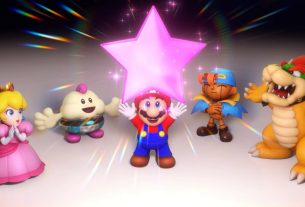Last weekend I was lucky enough to attend a launch party celebrating the opening of Indie Game Revolution, a new exhibit at Seattle’s Experience Music Project sponsored by Nintendo. This massive multimedia experience focuses on not only new and upcoming independent video game projects, but on the very history of indie development itself.
The first round of featured games for the exhibit-proper includes quirky, high-minded fare like Gone Home and Papers, Please, but, as this was a launch party, my experience was a good bit more upbeat than these rather weighty titles may lead you to believe. With a focus as clearly on fun as it was on art, my time at the EMP event had the makings of any great geek’s night out. There was music – we were, after all, in Seattle – and photo ops and food and beer – again, because Seattle – and even a series of presentations hosted by Redmond’s DigiPen Institute of Technology.
But mostly there was games.
 EMP’s own press materials proudly proclaim that Indie Game Revolution “explores how the independent video game community is pushing past conventional boundaries,” and the titles on display proudly ran the gamut. There was the big, beautiful Metroidvania world of Drinkbox Studios’ Guacamelee!: Super Turbo Championship Edition, looking just as vibrant (and wonderfully ridiculous) as ever on the Wii U. There was also the console variant of current 3DS standout Shantae and the Pirate’s Curse, a game that arrives in your living room with its perfectly pixelated platforming intact, but with gorgeous HD pop-out models used for the game’s frequent dialog breaks.
EMP’s own press materials proudly proclaim that Indie Game Revolution “explores how the independent video game community is pushing past conventional boundaries,” and the titles on display proudly ran the gamut. There was the big, beautiful Metroidvania world of Drinkbox Studios’ Guacamelee!: Super Turbo Championship Edition, looking just as vibrant (and wonderfully ridiculous) as ever on the Wii U. There was also the console variant of current 3DS standout Shantae and the Pirate’s Curse, a game that arrives in your living room with its perfectly pixelated platforming intact, but with gorgeous HD pop-out models used for the game’s frequent dialog breaks.
But these demo stations were situated beside more esoteric options like the exclusive Affordable Space Adventures and its heavily atmospheric, almost minimalist approach to exploration, or the multicolor madness of Runbow. (That latter title combines the visual aesthetic of Saul Bass with the perfectly distilled essence of a New Super Mario Bros-style platform racer, and whips it into pure multiplayer bliss.)
And yet in all this I kept coming back to the same question; why Nintendo? Why would a company synonymous with big budget first-party titles suddenly display such a passion for independent creations and their creators? It seemed like a legitimate question, so I took it to the source.
 David Wharton, Director of Marketing and Analytics for the Nintendo eShop, and Damon Baker, Senior Manager of Marketing for the Licensing Department, were on-site, and we sat down for a talk. The guys didn’t exactly disagree with my assessment of Nintendo as a major first-party house, but they preferred to describe it a different way – as a developer-driven company dedicated to the individual expression of those game developers. That, they said, explained the link between Nintendo as a company and independent games as a contemporary movement.
David Wharton, Director of Marketing and Analytics for the Nintendo eShop, and Damon Baker, Senior Manager of Marketing for the Licensing Department, were on-site, and we sat down for a talk. The guys didn’t exactly disagree with my assessment of Nintendo as a major first-party house, but they preferred to describe it a different way – as a developer-driven company dedicated to the individual expression of those game developers. That, they said, explained the link between Nintendo as a company and independent games as a contemporary movement.
I believe David summed it up perfectly:
“With Miyamoto, back when he started, you could think of him as an independent game developer. He wasn’t supported by a massive studio; it wasn’t like there was a huge industry he was trying to fuel. He actually ended up helping to create that industry on the backs of his ideas and his creative vision — how he felt like he could entertain people through technology.”
Damon continued saying that Indie Game Revolution was simply about showcasing creativity in the uniquely flexible independent sphere. Nintendo’s video game legacy began as an original idea – a silly character trying to save a woman from Donkey Kong. “And what’s to say,” David added, “that some of the games in the exhibition today aren’t on that same road?”
Those words stuck with me as I continued through the exhibit, hitting up the food trucks before wandering downstairs to watch fans queue up to take part in the Nidhogg tournament. Indie gaming, I concluded, is about whatever you want it to be about, even a trippy hybrid of fencing and digital tug-of-war. Perhaps one of those kids staring intently at the screen, gripping his controller as if his life depended on it would find the inspiration in that moment to someday take gaming to as yet unimagined levels.
 I ascended back to EMP’s upper level to the twin tones of blissful revelry and agonizing defeat. While the Nidhogg qualifiers were just picking up below us, an informal but no less heated competition was commencing at the Sportsball demo stations. Combining the combat of Joust with the preternatural soccer aesthetic of J.K. Rowling’s Quidditch, Sportsball had been attracting crowds all night – even Damon and David spent some time engaged in a little good-natured competition. Now that crowd was fast becoming a throng, and even those engaged in other games at other stations couldn’t help but crane their necks at the growing excitement. Two two-player teams were fiercely controlling their avian-mounted avatars, desperately trying to direct colored balls toward the game’s center goal (and literally squashing the competition for good measure).
I ascended back to EMP’s upper level to the twin tones of blissful revelry and agonizing defeat. While the Nidhogg qualifiers were just picking up below us, an informal but no less heated competition was commencing at the Sportsball demo stations. Combining the combat of Joust with the preternatural soccer aesthetic of J.K. Rowling’s Quidditch, Sportsball had been attracting crowds all night – even Damon and David spent some time engaged in a little good-natured competition. Now that crowd was fast becoming a throng, and even those engaged in other games at other stations couldn’t help but crane their necks at the growing excitement. Two two-player teams were fiercely controlling their avian-mounted avatars, desperately trying to direct colored balls toward the game’s center goal (and literally squashing the competition for good measure).
I found myself wondering if developer TOO DX, the four-man team behind this over-the-top sports title, could one day give us the next big franchise – a Mario Bros. or a Legend of Zelda or a Pokémon. At that moment it seemed perfectly possible. After all, Shigeru Miyamoto was only one man.
Travel and accommodations provided by: Nintendo of America (via GolinHarris)
Special thanks to Nintendo’s Damon Baker and David Wharton; EMP’s Anita Woo; my local pals Brooks Callison and Steve and Thaddeus Holetz; and GolinHarris’s Deanna Avilla and Aaron Palacios for all the time and assistance they provided before, during and after this event. Y’all’re the greatest!




